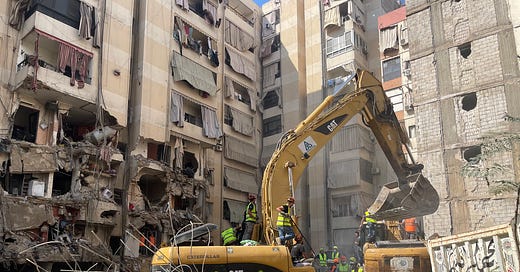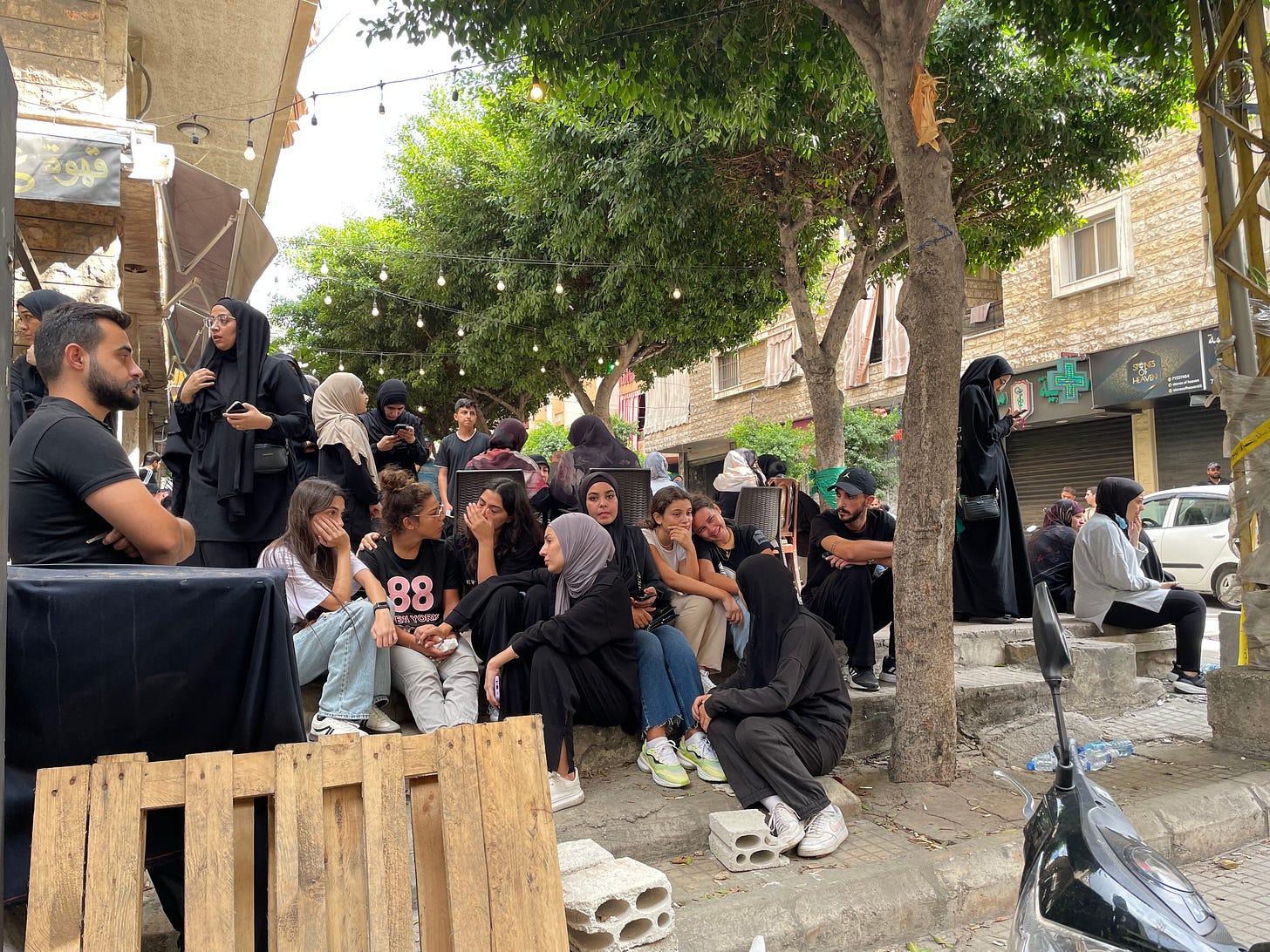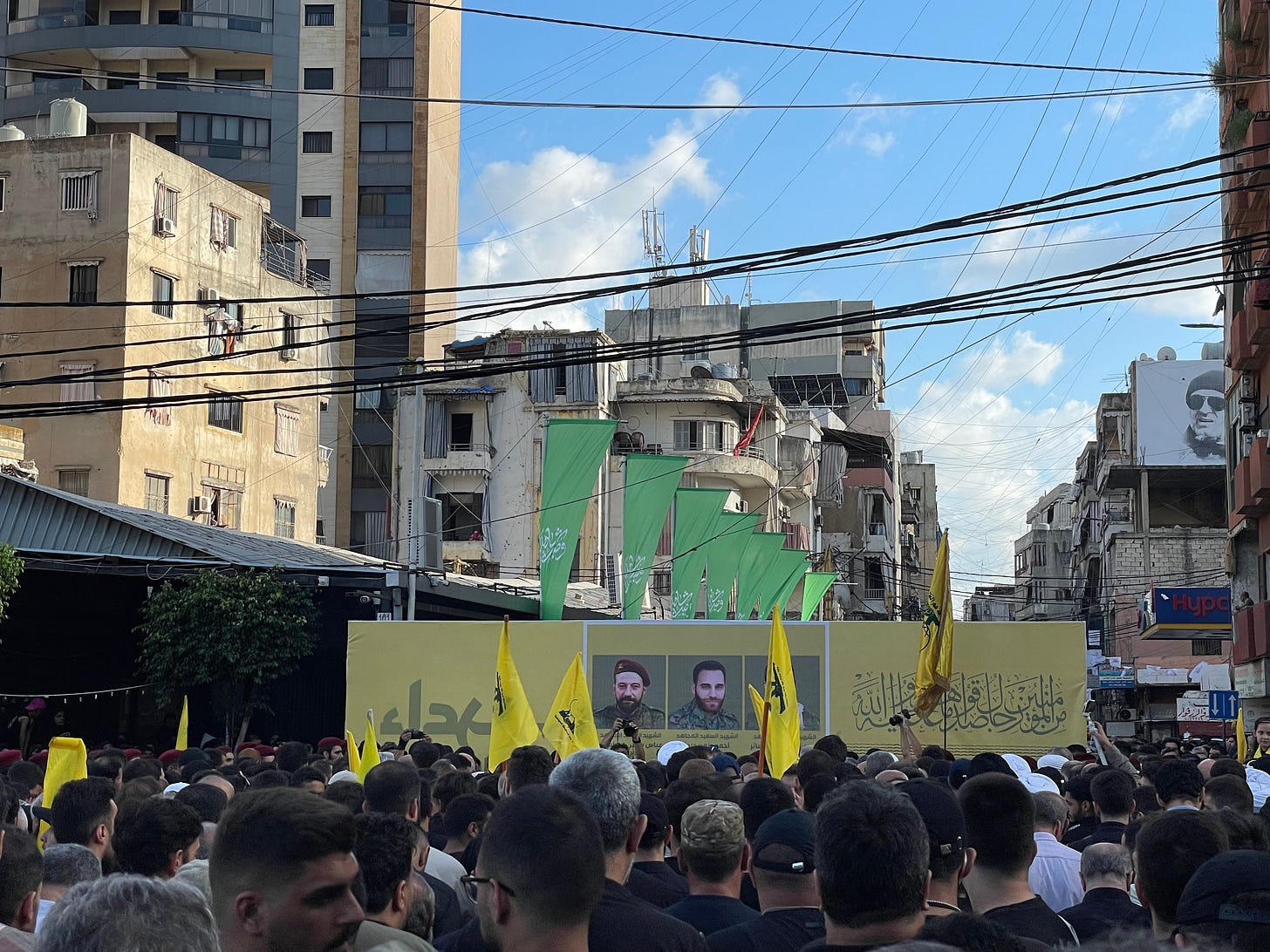In the Hezbollah stronghold of Dahiye in Beirut, locals deal with the fallout from a deadly Israeli airstrike and attend a funeral for dead fighters
A digger is grappling with the piles of rubble that is all that’s left of two buildings that once stood on this spot in Dahiye, a densely populated neighbourhood and Hezbollah stronghold in southern Beirut.
In a bunker, metres below the now flattened multi-storey building, a group of Hezbollah members had held a fateful meeting on Friday afternoon. It was attended by Ibrahim Aqil, a senior Hezbollah commander who had been released from hospital earlier that day after he was injured in the pager attacks that hit hundreds of Hezbollah members on Tuesday.
It would be followed a day later by a smaller but more lethal wave of attacks involving detonating walkie talkies. The attack which has been widely attributed to Israel sowed chaos and terror across Lebanon, particularly among Hezbollah members. Hezbollah’s leader described the attacks using hundreds of wireless devices as “a declaration of war.”
With the Iran-backed paramilitary group no longer able to rely on pagers and walkie talkies and fearful of Israeli or American surveillance while using normal phones, meeting in person must have seemed like the only way to have a discussions on how to response to the series of embarrassing security breaches and attacks on Hezbollah.
A group of Hezbollah commanders including Aqil and fighters from the Radwan Unit, an elite infantry force, travelled to the underground bunker in Dahiye on Friday.
The decision would be a fatal mistake for 16 of the Hezbollah members who were targeted by ground penetrating Israeli missiles fired from the skie by a F-35 jet. The force of the missile strikes blew the sides off many of the surrounding buildings. I could see the open cabinets of one kitchen lying exposed with a washing machine perched on an open ledge 5-stories high
I spoke with someone living nearby who said their apartment shook violently when the missiles struck the ground. One Ethiopian woman working for a family nearby described having to climb out over rubble to escape her building.
Soon after the attack which was immediately claimed by Israel, families began posting photos online trying to learn the whereabouts of their missing loved ones. Some were located in hospitals while 46 are now confirmed dead including 7 women and three children.
When I arrived at the site on Saturday, a group of locals were still waiting for news of their missing loved ones. 15 are still missing, their remains believed to be somewhere under the rubble.
A civil defense worker told me that no one was expected to be discovered alive at this point. A group of volunteers from the Lebanese red cross were on standby but no one was expecting to rush anyone to hospital at this point.
Hours later, five members of the Hamdane and four members of the Dakdouki family were found dead under the rubble. Several more people remain missing, while remains have been taken for DNA tasking, according to the Lebanese ministry of health.
Hezbollah has a political wing with members of the Lebanese parliament. That includes Minister of Public Works and Transport Ali Hamieh who visited the site on Saturday and said that the bombing of a residential building constituted a “war crime” and that Israel was “dragging the region into a war”.
A short drive away a funeral was being held for three of the Hezbollah members killed in the strike on Friday. A sea of black clothing punctured by bright yellow flags with the emblem of Hezbollah cascaded through the streets. The crowd was largely divided by gender, with men and older boys standing together and women and young children elsewhere.
After walkie talkies detonated at a funeral on Wednesday for victims of the pager attacks the day before, the atmosphere was uneasy to day. Soldiers stood watch at the edges of the event and bags all searched. Some men walked by with red coloured eyes, another with a bandaged hand, perhaps wounds from the pager attacks that had hitten so many from this neighbourhood in southern Beirut.
Prayers were recited across speakerphones but the low hum of Israeli drones could be heard in between the music. Attendees pledged themselves to Allah and Hezbollah while fists punched the air.
The three coffins of the slain Hezbollah fighters were dropped in Hezbollah flags and carried through the crowds, as if levitating across a black river. Some women cried while others took photos of their children standing by the photos of the fallen fighters - these children part of the latest generation to grow up amid war.
The Israeli strike on Friday represents yet another security breach in a week of devastating and disorientating blows for Hezbollah. Hundreds of the group's members were injured and some permanently maimed in two waves of detonation from rigged communication devices used by Hezbollah which killed 37. Considered Iran’s most formidable proxy force in the region, some in Lebanon's Shia community, which Hezbollah draws much of its support from, are questioning how the group’s operations could have been compromised so badly in the attacks widely attributed to Israel.
On Saturday night, Israeli forces struck dozens of targets in southern and eastern Lebanon in an intensive bombardment, killing at least one, according to Lebanon's health ministry. Hours later on Sunday morning, Hezbollah fired over 100 rockets and missiles into Israel targeting the Ramat-David military base and an airport near the northern Israeli city of Haifa. The barrage of missiles was the deepest attack yet into Israeli territory since the war began and a response to Israeli strikes on southern Beirut, said Hezbollah. Several of the projectiles evaded Israel’s Iron Dome defense system, with fires near Haifa and four people injured, according to the Israeli military.
Several airlines have cancelled flights to Beirut, while in a statement on Sunday, the UN Envoy to Lebanon, Jeanine Harris, described the region on “the brink of an imminent catastrophe” and said “no military solution” will make either side safer.











